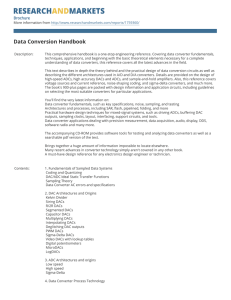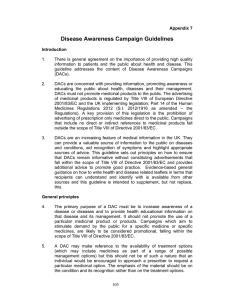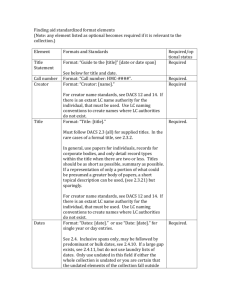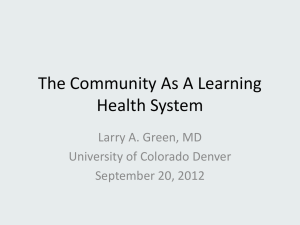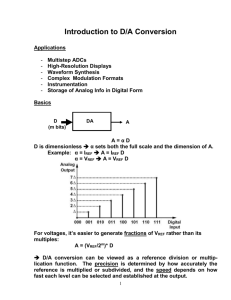Public Health Delivery And Cost Studies (DACS): Using Practice
advertisement
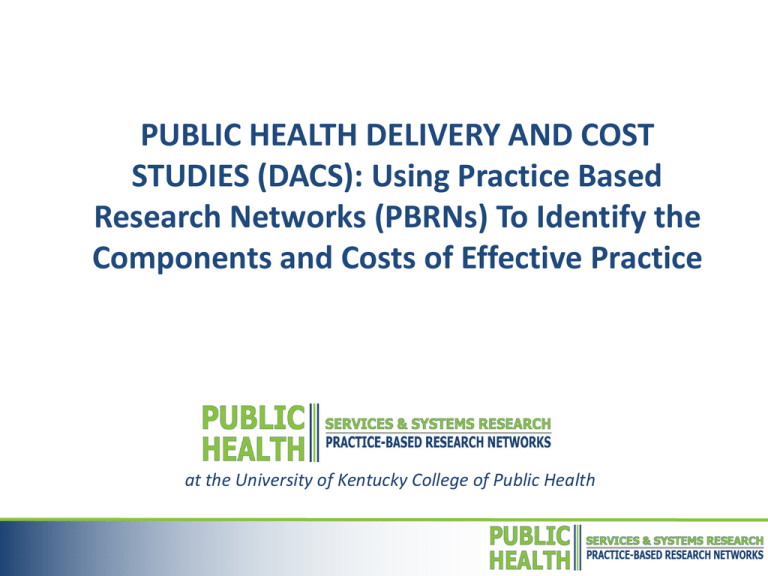
PUBLIC HEALTH DELIVERY AND COST STUDIES (DACS): Using Practice Based Research Networks (PBRNs) To Identify the Components and Costs of Effective Practice at the University of Kentucky College of Public Health BACKGROUND Public Health (PH) Practice Based Research Networks (PBRNs) National program of the Robert Wood Johnson Foundation (RWJF) that supports research-practitioner networks in improving delivery of PH services PBRNs combine multiple PH agencies with research partners to design & implement comparative studies in real-world practice settings PH Delivery and Cost Studies Award (DACS) support studies to identify costs of delivering high value PH services & elucidate influence of delivery system characteristics on efficiency, effectiveness, & equity of services. WHY FOCUS ON COSTS 1/2 • Wide variation in scope & scale of PH activities across communities & their financial & institutional arrangements • Gaps in knowledge on causes & consequences of variation; resources required to deliver PH services for a defined community & group (Carande-Kulis et al., 2008) • Lack of empirical evidence related to the “production function” of PH activities Essential to informing PH funding decisions & sound economic justifications for PH investments (e.g. Neumann et al., 2009) Guide financial management decisions of PH agencies in prioritysetting & evaluation of efficiency & cost-effectiveness of PH strategies (Kindig & Mullahy, 2010) WHY FOCUS ON COSTS 2/2 • Lack of systematic knowledge about costs of delivering PH services → decision-makers to rely more on historical precedent > empirical data in establishing fiscal priorities, financial mechanisms, & operating budgets (Budetti & Lapolla, 2008) • 2012 Institute of Medicine Recommendations Identified high priority need for studies that explicate components & costs of a minimum package of public health services (1) foundational capabilities (2) basic programs Institute of Medicine. For the Public’s Health: Investing in a Healthier Future. Washington, DC: National Academies Press; 2012. General Analytical Framework & Key Empirical Questions • Costs incurred in delivering PH services shaped by: 1.Delivery system structure & operation 2.Pop. Characteristics 3.Nature & quality of services • Delivery system is a complex mix of governmental, private, community, non-for-profit, & other contributing organizations Question of how delivery system characteristics influence costs • Level of resources required to deliver a given bundle of PH activities for a given population How do delivery costs vary across communities & population groups • DACS policy relevance for efficiency & ROI Where are the opportunities to realize efficiencies in delivery? Do outcomes achieved by PH interventions justify their costs? Where should new investments be directed to achieve greatest impact? DACS Category 1: Cost Measurement & Comparison Studies • 12 months: CA, NE, NJ • Standard cost-estimation methodology in measuring costs of delivering service(s) in at least 4 different practice settings in PBRN network over a defined period of time Distinguish fixed and variable costs Break down costs into standard components, incl. personnel, nonpersonnel, & indirect/overhead costs Define & measure units of service delivered in order to estimate unit costs for each practice setting • Comparative analyses: characterize patterns of variation in costs of service delivery across participating practice settings identify major sources of variation in costs such as those attributable to underlying factors and economies of scale & scope DACS Category 2: Delivery System Comparison Studies • 18 months: CO, CT, FL, NY, NH, NC, OH, WA • Same cost measurement & estimation methods used in Category 1 studies • More elaborate research designs & analytic strategies to investigate relationship between delivery system characteristics & cost of delivering services. • Larger number of practice settings in in order to test specific hypotheses about system characteristics & their impact on service delivery. • Alongside cost measures, collect measures of service delivery reach, effectiveness, and/or equity to explore inter-relationships among these factors & examine how they collectively determine value of public health services. DACS Grantees by PH topical area: STD / HIV • New York (2) - Optimizing the Use of HIV/STD Partner Services (PS) Strategies – Practice setting in 4 pilot counties – Examine variation between county & state delivered PS programs – Model impact of different PS strategies on cost & effectiveness of PS programs – Make recommendations related to the conditions under which re-allocating resources will improve efficiency. • Florida (1) – Comparative Cost Study of STD Services in Florida & Georgia – All county health departments in FL – Identify unit costs of STD prevention & control services & effect on costs of delivery system variations incl: • Standardization & centralization of programs & IT & HR systems • Economies of scale as it relates to CHD population jurisdiction size • Revenue support for services & responsiveness to local community governance DACS Grantees by PH topical area: Tobacco Control • NJ (1) – Determining the Public Health Costs of Tobacco Prevention & Control: A Comparison of 5 New Jersey Local Health Departments – 5 representative LHDs selected based on diversity of population characteristics, geographic jurisdiction level, & admin structure – Estimate total costs of PH tobacco prevention & control activities – Determine cost structure as it relates to the resources involved in providing service & compare costs across practice settings. • NH (2) – Understanding governmental & non-governmental funding & network structures in different models of PH infrastructure – 4 regional PH networks with representative community partnership structures – Identify funding sources & Develop methods to collect data for future research involving financial assessments of other PH activites – Determine relationship between service funding & PH local system network connectivity DACS Grantees by PH topical area: Other Services • CA (1) – Public Health Delivery and Cost Studies in the San Joaquin Valley – Estimate costs of 3 PH services: (1) TB Control; (2) Child Immunization; & (3) Community Needs Assessment in 4 rural LHDs in SJV • CT (2) – Cost Effectiveness, Efficiency, & Equity of Inspection Services throughout Connecticut’s Local PH System – All CT LHDs and districts – Component 1: Examine scope & cost of 4 environmental health services: (1) Food protection services (2) Public water wells; (3) Sub-surface sewage disposal; (4) lead poisoning; prevention; & control – Component 2: Economic evaluation of efficiency, effectiveness, & equity of food protection services • NE (1) – Measuring QI implementation costs among 4 different LHD settings – – – – QI 1: financial management in credit card charges QI 2: increased individualized breastfeeding education in WIC program QI 3: management in policies & procedures QI 4: chronic disease management in Living Well program DACS Grantees by PH topical area: Multiple Programs (1/2) • CO (2) – Economic Cost Function of Select Core PH Services – All LPHAs in Colorado – Examine how LPHA structural differences modify cost of core service delivery; examine variation in cost across LPHA system factors; & generalizability of LPHA cost models outside of CO. – Leading candidates for evaluation: (1) Tobacco control; (2) Unplanned pregnancy prevention; (3) Nutrition; (4) Physical Activity; (5) Oral Health • NC (2) – Influence of Organizational and Community Characteristics on the Cost of Providing Mandated Public Health Services in North Carolina – 16 representative LHDs – Mandated services include: (1) food, lodging, & institutional sanitation; (2) individual on-site water supply; (3) sanitary sewage collection, treatment & disposal; (4) communicable disease control; (5) vital records registration DACS Grantees by PH topical area: Multiple Programs (1/2) • Ohio (2) – PH DACS Study – Empirical cost model of 5 core PH services from all OH LHDs • Per unit costs • Organizational & community factors affecting PH service delivery • Relationship between equity of resource allocation & PH outcomes – Direct observational approach to examine 1 core service: PH nuisance abatement • WA (2) – Washington State’s Foundational Public Health Services (FPHS): Determining Costs & Cost Drivers – statewide – Part of a larger state FPHS effort – Estimate & validate cost per unit of service of selected FPHS – Effect of organizational & community factors on delivery cost – Relationship between cost variation & equity of resource allocation Cost measurement, estimation, & analysis • Cost measurement methods Direct observational methods Time studies, time & motion methods Activity logs Analysis of administrative data; secondary data Surveys of program delivery staff, managers/directors; key informants Others • Estimation & Analysis Identifying components of costs; cost allocation Determinants of costs; estimate cost(production) functions Examine cost variation, heterogeneity, efficiency Statistical, descriptive comparison of cost Stochastic frontier analysis (e.g. technical efficiency) Data envelopment analysis (e.g. economies of scope) Ongoing Activities & General Timeline • July 2013 Kick-off • Methods & capacity-building workshop in late September • Peer review of protocol/instruments • Consortiums & collaborations between PBRNs in effort to standardize methods, find common set of services (show e.g.) • In-person meeting @Keeneland in April 2014 • July 2014 – Category 1 projects end • January 2015 – Category 2 projects end Overall Picture: How & where does DACS fit 1/2 PH PBRN Research Streams Delivery System Organization & Structure Practice Variation Volume, Intensity, & Quality of Delivery (*) Cost of Delivery Value & ROI of Public Health Other ongoing initiatives • RWJF Foundational Capabilities Initiative • RWJF Cost-Estimation Workgroup • HHS/RWJF PH National Chart of Accounts * MPROVE – Multi-Network Practice & Outcome Variation Examination Study CONTACT Public Health PBRN/PHSSR National Coordinating Center University of Kentucky College of Public Health Lexington, KY 40536 Phone: 859-218-0113; Fax: 859-257-3748 Email: publichealthPBRN@uky.edu Website: www.publichealthsystems.org/pbrn
